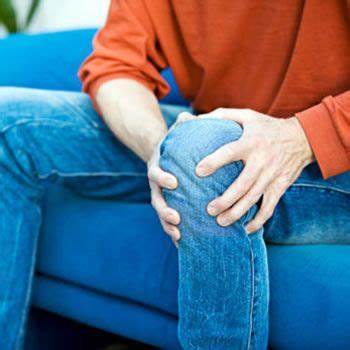Knee Pain Relief for Men
By Dennis Thompson Jr. | Medically reviewed by Niya Jones, MD, MPH
You may take your knees for granted, but physical exertion and other stresses take their toll on these all-important body parts. Find out why men get knee pain and how it can be treated.
 Your knees are very vulnerable joints that must hold up under a great deal of stress from everyday activities. Whenever you lift something or kneel down, you put strain on your knees. When you jog or take an aerobics class, your knees experience quite an impact, even as the rest of your body benefits from the exercise.
Your knees are very vulnerable joints that must hold up under a great deal of stress from everyday activities. Whenever you lift something or kneel down, you put strain on your knees. When you jog or take an aerobics class, your knees experience quite an impact, even as the rest of your body benefits from the exercise.
About 1.3 million people with acute knee trauma are seen in U.S. emergency departments every year. Most knee pain is caused by osteoarthritis . Another common cause of knee discomfort is patellofemoral syndrome, also known as "runner's knee," which stems from a strain on the tendon that attaches the kneecap to the lower leg. For men over 50, the source of pain may be tears of the menisci, the cartilage that provide structural support to the knee.
The knee is particularly vulnerable to long-term damage because it doesn't finish completely forming until men are in their late 20s. The knee often undergoes a fair amount of stress before it has fully matured, leaving it open to further damage and knee pain later in life.
Knee Pain: Understanding the Causes
Alan Gustafson, 53, of Salem, Ore., first noticed pain in his right knee in the fall of 2008, while he was jogging. "It was a pretty sharp pain," Gustafson said. "I had to stop." Looking back, he thinks he actually hurt himself lifting weights on a leg extension machine.
There are many reasons men might experience knee pain, including:
- Arthritis. Of all of our joints, the knee is most often affected by osteoarthritis, a degenerative process in which the protective cartilage in the joint wears away. It causes chronic pain in the knee, particularly during movement.
- Patellofemoral syndrome. Overuse and overexertion injuries often lead to this condition. A man might feel a dull, aching pain under or around the front of the kneecap. It can be caused by a combination of patellar tendon strain, torn cartilage, and a kneecap that's out of proper alignment.
- Torn cartilage. Trauma to the knee or overexertion can tear the menisci. This often occurs with sprains. A man who has a torn meniscus will feel sharp pain in the affected knee, and the knee may begin to lock up over time.
- A strain or sprain of the knee ligaments or muscles. This is usually caused by a blow to the knee or a severe twist of the knee. A man who suffers a sprain or a strain will experience pain, swelling, and difficulty walking.
- Tendonitis. Overuse during activities like running, jumping, cycling, or team sports can cause tendonitis, or inflammation of the tendons, the connective tissue that links muscle to bone. This causes significant pain in the front of the knee, especially when walking up or down stairs or hills.
Knee Pain: Reaching a Diagnosis
Doctors have a number of ways to diagnose knee problems:
- Imaging tests like X-rays, MRIs, and CT scans, allow doctors to look inside the knee.
- Arthroscopy uses a small tube with a tiny camera, or arthroscope, that’s inserted into the knee. The camera technology allows images from inside of the knee to be projected onto a screen, enabling doctors to perform a thorough evaluation of the joint.
- Radionuclide bone scan involves injecting a small amount of radioactive material into the patient. This allows doctors to assess blood flow to the bone and other parts of the knee, as well as cellular activity in the bone.
Knee Pain: Treatment Options
Fortunately, there are also a number of remedies for knee pain, depending on the cause of the problem, such as:
- Resting the knee and icing it for 15 to 20 minutes every three to four hours for the first couple of days following pain or injury.
- Using crutches to take pressure off the knee while it recovers.
- Wearing a knee brace to support ligaments and other structures that may have been weakened by the injury.
- Taking medications to ease swelling and discomfort, including aspirin, acetaminophen (such as Tylenol), and non-steroidal anti-inflammatory drugs (NSAIDs) like ibuprofen (Nuprin, Motrin, Advil, and other) and naproxen (Aleve).
- Getting steroid injections into the knee joint to blunt severe pain from chronic conditions like arthritis.
- Strengthening the muscles that support the knee with physical therapy. Therapy should include quadriceps, hamstring, and calf stretching, and low-impact aerobic activities such as cycling, swimming, walking, and cross-country skiing. Try These
- Having surgery when necessary to repair torn cartilage or other chronic problems.
Clearly, exercise and other physical activity is good for you, but you must always remain in tune with your body and pay attention to knee pain when it occurs. If you ignore it, you run the risk of making it worse.
Related Articles
Back to Articles


 Your knees are very vulnerable joints that must hold up under a great deal of stress from everyday activities. Whenever you lift something or kneel down, you put strain on your knees. When you jog or take an aerobics class, your knees experience quite an impact, even as the rest of your body benefits from the exercise.
Your knees are very vulnerable joints that must hold up under a great deal of stress from everyday activities. Whenever you lift something or kneel down, you put strain on your knees. When you jog or take an aerobics class, your knees experience quite an impact, even as the rest of your body benefits from the exercise. 






